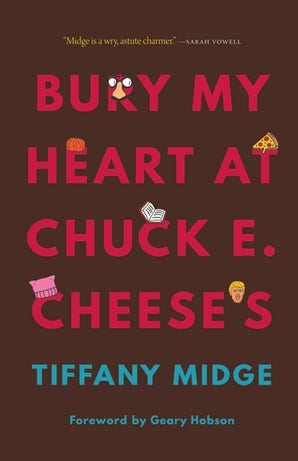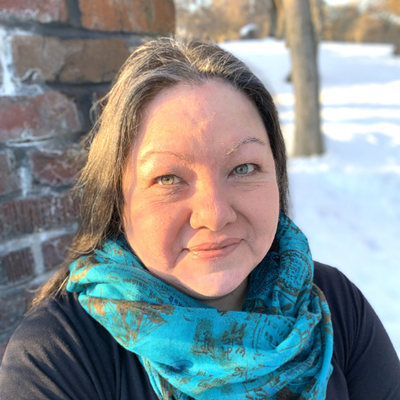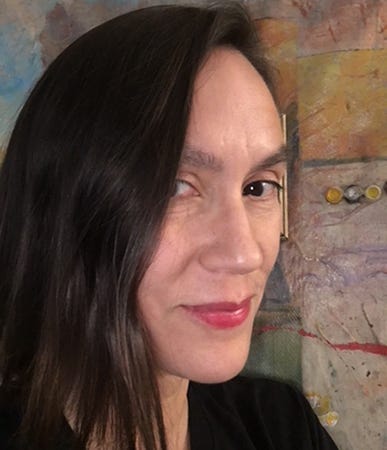
Tiffany Midge is an enrolled citizen of the Standing Rock Sioux Nation, the author of the award-winning poetry collection The Woman Who Married a Bear (University of New Mexico Press), and I am the president of her fan club. Not really, but I do use an awkward amount of heart and laugh reacts on everything she posts on Facebook, and I have been telling everyone I know (and sometimes strangers) about her new essay collection, Bury My Heart at Chuck E. Cheese’s (University of Nebraska Press).
When she began to write columns for Indian Country Today, I was among the many people who would race to see what she had to say about whatever world or pop culture events were happening at the time. When goings-on seemed surreal, we could count on her column to pierce through the poisonous haze with insightful, hilarious satire or witty and generous takes on Indigenous life.
When Indian Country Today changed forms, I desperately missed the columns, though of course she publishes in other places, like McSweeney’s, Waxwing, and World Literature Today, and I followed her writing there too. When I found out she was releasing a collection of the columns, along with other essays, I could hardly wait — and Bury My Heart at Chuck E. Cheese’s is definitely worth waiting for.
I caught up with Midge in between her book travels to talk writing, humor, and what’s next.
Stacy Pratt: The rest of us are fortunate enough to be reading Bury My Heart at Chuck E. Cheese’s. What are you reading right now?:
Tiffany Midge: I just received a copy of Navajo writer Natanya Ann Pulley’s With Teeth to review. And Nez Perce writer Beth Piatote’s The Beadworkers, also to review. I love dipping into Elissa Washuta’s and Theresa Warburton’s anthology Shapes of Native Nonfiction: Collected Essays by Contemporary Writers. Choctaw writer Devon Mihesuah is smart and hilarious. I love her Native Studies murder mystery Documents of Expectation, and I’m always reading from it and several others of her amazing books. Other books I’m dipping into are My Sister, the Serial Killer; My Year of Rest and Relaxation; Mostly Dead Things; and The Nickel Boys. My bedside area looks like the Leaning Tower of Pisa, and just as tall.
SP: How did the immediacy of writing a column affect your writing process, especially as a humorist?
TM: The immediacy of writing a column meant that I could justify subscribing to The New Yorker, The New York Times, and the Washington Post — because I had to keep up on current events, and read all of the other satire and humor articles and op-eds. I’ve since had to unsubscribe, unfortunately. Indian Country Today changing leadership and restructuring ended my little gravy train. It was sweet while it lasted. And for a tiny little while I felt like a contributing member of society. The crests for me hit during the weeks leading up to the election and post-election when everyone was stumbling around in disbelief and shock and trying to reconcile the fact that our worst fears and those science fiction classics foretelling robot overlords and the end to humanity were coming true. Writing columns was my way of coping with it, my version of resistance, and the hope for either comfort or transcendence, or both.
SP: You are known as a poet. What made you decide to publish an essay collection?
TM: Over the course of 18 months I published 40 essays — mostly in Indian Country Today as humor/op-ed columns — but also in several other online venues as well. Having an editor emailing regularly and asking for your next piece is the most effective incentive I can think of for positive productivity. It didn’t occur to me to compile a collection of essays and memoir pieces for a long time. I originally placed the bulk of what now makes up Chuck E. Cheese into a poetry collection, inspired by the critically acclaimed Citizenship by Claudia Rankine. What attracted me to Citizenship were the discussions on race and white supremacy, and for her nontraditional approach to poetry, and to form. The difference of course, was that my manuscript used humor. I sent out my nonstandard-looking poetry collection, titled First World (Story) Problems to a contest, and to some poet-friends, but then very soon following I guess it occurred to me to switch it up and make it an essay collection. It just seemed like a logical move. I’m really glad I did. It was a leap of faith.
SP: This collection includes many essays on historic events and pop culture references. How do you hope it will be received in the future, as a witness to its time?
TM: Yeah, perhaps it should be placed in a time capsule and buried in America’s proverbial back yard. Either that or shot in a rocket to outer space. Let the aliens deal with it and conclude that Chuck E. Cheese is a pagan god worshipped by ‘Mericans for its magical pizza.
SP: When I read this book, I feel like it was written for me…even when you’re directly addressing Peyton and Madison and Chai and the other white girls. Your work is shared widely, but what I love about it — and all your work — is that it feels like you are writing to or for Indigenous people rather than explaining Indigenous people to everyone else. Of course, with the ICT pieces, you were writing for a primarily Indigenous audience, but is that a deliberate choice in your writing, generally?
TM: My least favorite pastime is being professorial and explaining things. Either I’m too lazy or too worn down. I’d rather make jokes and tease, because it’s a better use of my time and actually requires an imagination. The jokes of course are mostly inside humor that most Natives will hopefully get, depending, and non-Native, Native Studies professors and non-Native, Native Lit professors. So, in that sense, yes, I wrote the columns for a Native audience, with the exception of the McSweeney’s open letters. Although I signed my name to them, they were written as a persona, the professorial Indian expert persona. Some of the longer memoir pieces, are examples of me trying to outdo myself, competing with myself to reasonably and coherently narrate personal stories and experiences. I worked with editors, also, for the publications they ended up in, and there’s influence there from the edited drafts. It takes a village, right? I’m grateful.
SP: Your essays are so personal, and they describe the life of an Indigenous person who is involved in theatre and interacts with popular culture and is otherwise not the stereotype of an Indigenous person in literature. Do you feel pressure to conform to expectations of Indigenous literature (particularly Indigenous women writers) and/or do you think the expectations are loosening up?
TM: Yes, “life of an Indigenous person who is involved in theater and interacts with popular culture…” or otherwise, is an actual, real life human being. Isn’t that funny? I’m sure you’ve dealt with that yourself. Like, Stacy, what kind of Native person loves Shakespeare and Heavy Metal [I used to teach British literature, and I’m in a metal band called Reliquario, and the fact a writer whose work I love noticed this…AAAAAHHHH!!! — SP]? Why aren’t you busy being an Indigenous stereotype? I don’t think I’ve felt pressure to conform to expectations in Indigenous writing, except by avoiding cultural content during writing workshops for my MFA. But I wasn’t exactly writing about Indigenous alienation from society, or the tortured angst of adolescence. I didn’t submit The Dreamcatcher in the Rye for my Master’s thesis.
SP: In your essay about how one of your satire pieces was taken seriously by actual journalists, you write that “artists and creators are critically necessary now more than ever. Especially humorists and writers of satire.” How do you see that need continuing, and why is it important that Indigenous voices be part of the humor response?
TM: America has news networks relaying half-truths and distortions, and late-night comedy hosts telling the truth. I saw that on a meme somewhere. The world is so bananas right now that we need doses of comedy to give comfort and levity, to make sense of things. I mean, Gary Larson is coming out of retirement! Things must be truly terrible if The Far Side is being exhumed. In my experience, and the way that I understand Native people and humor is that Native people have always recognized the power inherent in using humor to bridge, heal, and diffuse…and well, survive. Teasing is part of the social fabric, a way to bond and a way to tamp down inflated egos, knock the stuffing out of big-headed folks. Trump is a perfect target example of that. It takes audacity to count coup on one’s enemies by laughing at them. Satire is the language and expression of outrage and good satirists know how to use humor and wit as a means for critique against the institutions that oppress. Humor also serves as an act of resistance, which ultimately can lead to empowerment and transformation.
SP: You have a poetry book described as “comic” coming out later this year. What can you tell us about it?
TM: “Comic” in that I intended for the poems to be funny. But I recently met Emma Noyes, a member of the Confederated Tribes of the Colville Reservation, who is a writer and draws comics, and I was taken by the idea to have her illustrate my book. Her zine Draw Me Like One of Your Salish Girls totally delighted me. My poetry collection Horns will be published by the boutique Spokane press Scablands Books, and I’m thrilled to be working with Sharma Shields and editing with Maya Zeller Jewell. I love their books, I love what they’re doing, and their influence in how Spokane has been cultivating writing that is offbeat, speculative, fantastical and very funny. I’m a big fan of theirs and Horns found a perfect home in Scablands Books. They use a quote by Katherine Dunn, author of Geek Love, on their webpage, and that should tell you a lot about their tastes and aesthetics. I think of Horns as a kind of companion book to Bury My Heart at Chuck E. Cheese’s. And since the launch dates are so close together, they’re really more like fraternal twins. At least that’s how I think of them. Horns is due before the end of the year, or maybe very soon after the first part of the year.
***
Bury My Heart at Chuck E. Cheese’s is available now from the University of Nebraska Press. Horns is forthcoming from Scablands Books.

Tiffany Midge is a citizen of the Standing Rock Sioux tribe and was raised in the Pacific Northwest. She is a former columnist for Indian Country Today and taught writing and composition for Northwest Indian College. Her award-winning books are The Woman Who Married a Bear and Outlaws, Renegades, and Saints: Diary of a Mixed-Up Halfbreed. Her writing has appeared in McSweeney’s, Transmotion, the Offing, Waxwing, Moss, Okey-Pankey, Lit Hub, and World Literature Today. Midge resides in Moscow, Idaho, where she has served as the city’s poet laureate. She aspires to be the distinguished writer in residence at Seattle’s Space Needle.

Stacy Pratt is a Mvskoke writer on the arts…visual, musical and literary. She sings heavy metal and is a hagiographer in her spare time. Really.
I’d Rather Make Jokes: Stacy Pratt talks to Tiffany Midge was originally published in Anomaly on Medium, where people are continuing the conversation by highlighting and responding to this story.
